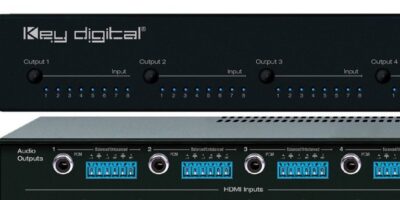HDMI matrix switcher is app-ready for AV integration, says Key Digital
The app-ready KD-MS4x4G and KD-MS8x8G 4 x 4 / 8 x 8 4K / 18G HDMI matrix switchers have independent audio switching or de-embedding of balanced / unbalanced and PCM digital audio.
The HDMI matrix switchers deliver the latest in UHD/4K and HDMI standards, says Key Digital. They offer 18Gbits per second and high dynamic range (HDR) support for image quality. The company’s extended display identification data (EDID) control ensures that the integrator is in charge of the communication, it adds. Independent audio routing means that the KD-MS4x4G and KD-MS8x8G can be used in both commercial and residential applications.
KD-MS4x4G and KD-MS8x8G support HDCP 2.2 and all SD, HD, and VESA (VGA, SVGA, XGA, WXGA, SXGA, UXGA) up to UHD/4K 18G 4096 x 2160 or 3840 x 2160 24 / 25 / 30 / 60Hz at 4:4:4 and 1080p. All UHD/4K EDID handshake files include HDR header information.
HDMI matrix switching for four (KD-MS4x4G) or eight (KD-MS8x8G) HDMI sources to four or eight HDMI outputs and four or eight analogue and digital audio outputs may be independently controlled to follow the HDMI output selection or separately switched to accommodate applications in professional AV systems integration.
The matrix switchers are fully licensed and compatible with HDCP 2.2 and feature support of HDR10 video which allows users to experience more life-like images through a greater range of luminance levels. Key Digital’s HDR10 delivery is handled as part of the proprietary Full-Buffer Technology (FBT). Studies have concluded that viewers prefer video signals with more contrast ratio vs higher resolution. The KD-MS4x4G and KD-MS8x8G deliver the highest possible support across both contrast ration and resolution, says Key Digital.
Full Buffer Technology manages transition-minimised differential signalling (TMDS) re-clocking and signal re-generation, high-bandwidth digital content protection (HDCP) authentication to source and display, and EDID handshaking control. Key Digital has had EDID control for over 12 years. EDID control has 15 different settings inside the software, many of which are now updated to contain HDR header information in the handshake. HDCP authentication on the HDMI input gives each source the information and file it needs and is 2.2-compliant. Forced hot plug detection enables the integrator or user to choose if the active signal voltage is forced to the connected input device.
KD-App and KDMS Pro give installers the tools to scan for and detect a pre-built GUI and TCP/IP control.




